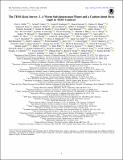The TESS–Keck Survey. I. A Warm Sub-Saturn-mass Planet and a Caution about Stray Light in TESS Cameras
Author(s)
Huang, Chelsea X.; Villanueva Jr, Steven; Osborn, Hugh P; Ricker, George R; Vanderspek, Roland K; Seager, Sara; Daylan, Tansu; Fong, William; Goeke, Robert F; ... Show more Show less
DownloadPublished version (1.374Mb)
Publisher Policy
Publisher Policy
Article is made available in accordance with the publisher's policy and may be subject to US copyright law. Please refer to the publisher's site for terms of use.
Terms of use
Metadata
Show full item recordAbstract
We report the detection of a Saturn-size exoplanet orbiting HD 332231 (TOI
1456) in light curves from the Transiting Exoplanet Survey Satellite (TESS). HD
332231, an F8 dwarf star with a V-band magnitude of 8.56, was observed by TESS
in Sectors 14 and 15. We detect a single-transit event in the Sector 15
presearch data conditioning (PDC) light curve. We obtain spectroscopic
follow-up observations of HD 332231 with the Automated Planet Finder, Keck I,
and SONG telescopes. The orbital period we infer from the radial velocity (RV)
observations leads to the discovery of another transit in Sector 14 that was
masked by PDC due to scattered light contamination. A joint analysis of the
transit and RV data confirms the planetary nature of HD 332231 b, a Saturn-size
($0.867^{+0.027}_{-0.025} \; R_{\rm J}$), sub-Saturn-mass ($0.244\pm0.021 \;
M_{\rm J}$) exoplanet on a 18.71 day circular orbit. The low surface gravity of
HD 332231 b and the relatively low stellar flux it receives make it a
compelling target for transmission spectroscopy. Also, the stellar obliquity is
likely measurable via the Rossiter-McLaughlin effect, an exciting prospect
given the 0.14 au orbital separation of HD 332231 b. The spectroscopic
observations do not provide substantial evidence for any additional planets in
the HD 332231 system, but continued RV monitoring is needed to further
characterize this system. We also predict that the frequency and duration of
masked data in the PDC light curves for TESS Sectors 14-16 could hide transits
of some exoplanets with orbital periods between 10.5 and 17.5 days.
Date issued
2020-04Department
Massachusetts Institute of Technology. Department of Physics; MIT Kavli Institute for Astrophysics and Space Research; Massachusetts Institute of Technology. Department of Earth, Atmospheric, and Planetary Sciences; Massachusetts Institute of Technology. Department of Aeronautics and AstronauticsJournal
Astronomical Journal
Publisher
American Astronomical Society